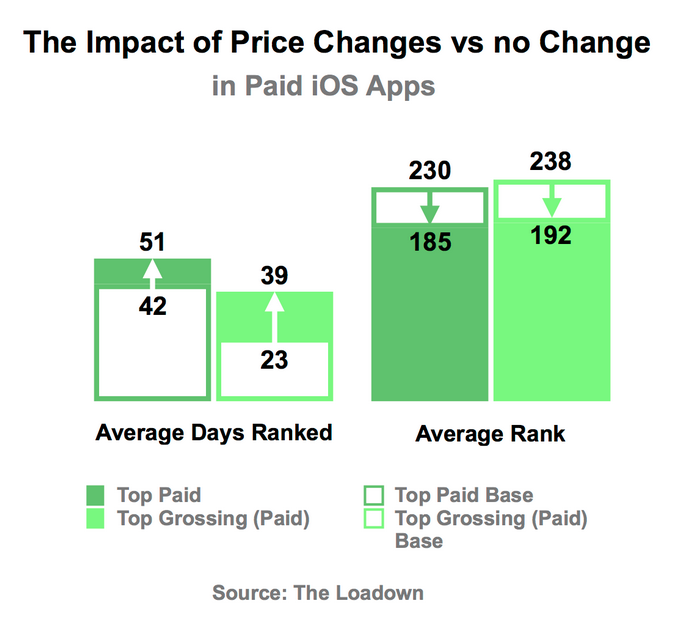Getting found in the iOS app store is a challenge, with more than one million active apps vying for users’ attention. App publishers and developers have a number of obvious marketing tools at their disposal, like advertising and pay-per download, to get more people to notice their mobile apps. But these are costly and not for everyone.
Beyond the obvious advertising tools, the iOS app store has another, often overlooked, way to promote discovery: app price changes. When a publisher or developer lowers the price of a paid app it gets added to Apple and third party RSS feeds that are distributed to thousands of sites and twitter feeds focused only on promoting apps that have gone on sale or have recently become free.
How it works
This marketing tool, more akin to merchandising, requires little to no budget but, according to our analysis of all iOS apps during most of 2013, it has a significant impact on positioning in Apple’s Top Paid and Top Grossing ranks. This directly translates into better visibility, downloads and revenue.
In fact, as can be seen in the graph below, compared to paid apps that never changed their prices, paid apps that made such changes (both increases and decreases) grew the average number of days they were ranked by 21% in Top Paid (+9 days) and 70% in Top Grossing (+16 days). These apps also improved their average rank by 20% in Top Paid (-45 positions) and 19% in Top Grossing (-46 positions). These improvements were not only for the most popular iOS apps, but also for less established new apps and poorly performing apps that have been around for a while.

The number of price changes, whether increases or decreases (including to $0) also matters. 1 or 2 changes during a year provides very limited improvements. But when changes are made once per month (12 total), improved rank and the number of days ranked healthily. Increase that number to 1 per week (52 total) or more and that’s when developers started to see the largest improvements to app ranks and thus downloads.
Applying this to your app
Here are the key rules that mobile app publishers and developers should follow when developing their price marketing strategy:
Repeat Frequently
All paid apps should look to go on sale, on average, at least once per month. With the corresponding price increase, that makes 24 price changes per year. More experienced app developers and marketers can look to do more to maximize downloads, including intraday changes to target specific countries or types of users, but 1 per month is a good start for most apps.
Allow Settling Time
Price changes can take anywhere from 20 minutes to more than 15 hours to spread throughout iTunes’ storefronts (New Zealand is usually one of the first then it follows time zones to reach European storefronts and the US). In addition, it can take time for users to discover the new price, either directly or through a third party site like AppShopper. So unless you are looking to make multiple price changes a day, which can be rewarding but requires constant attention and/or the right tools, most publishers should let their app’s sale breathe for 48 to 72 hours.
Focus on Down Cycles
Given the cyclical nature of downloads and ranks, price changes should generally not be made when the app is experiencing a growth spurt. Instead, the price change should be timed with an app’s slowing downloads or sagging rank.
React to Competition
If your app is a soccer app at $2.99 and EA’s FIFA 2014 goes from $4.99 to $0.99, you need to react immediately, in order protect your positioning and sales. If this example does not directly apply to you, remember that competitors are not just direct competitors. They may also be apps ranked just above you in your genre or category, or those appearing before you in key searches on iTunes.
Avoid Predictability
Varying the times, days of the week and the amounts of your price changes will avoid predictability that could be gamed by both competitors and users.
Test Often
Every price change should be an opportunity to test a new price and new price steps. That may not always be possible if you are at $0.99 and going free. But even then you should be testing various target prices (the price you go to after a sale). Here are examples of variations in price changes:
- The price of your app is lowered to varying tiers in 1 or 2 steps (e.g. $3.99 -> $0.99 or $3.99 -> $0.99 -> $0.00)
- Then the price is increased in 1-3 steps (e.g. $0.99 -> $3.99, $0.99 -> $4.99 -> $3.99, $0.99 -> $1.99 -> $3.99)
Pricing changes are a simple, effective way to get your app in front of people. You can make these changes yourself, or if you’re looking for some extra assistance, talk to us. The Loadown can help you automate this exact type of optimization.
